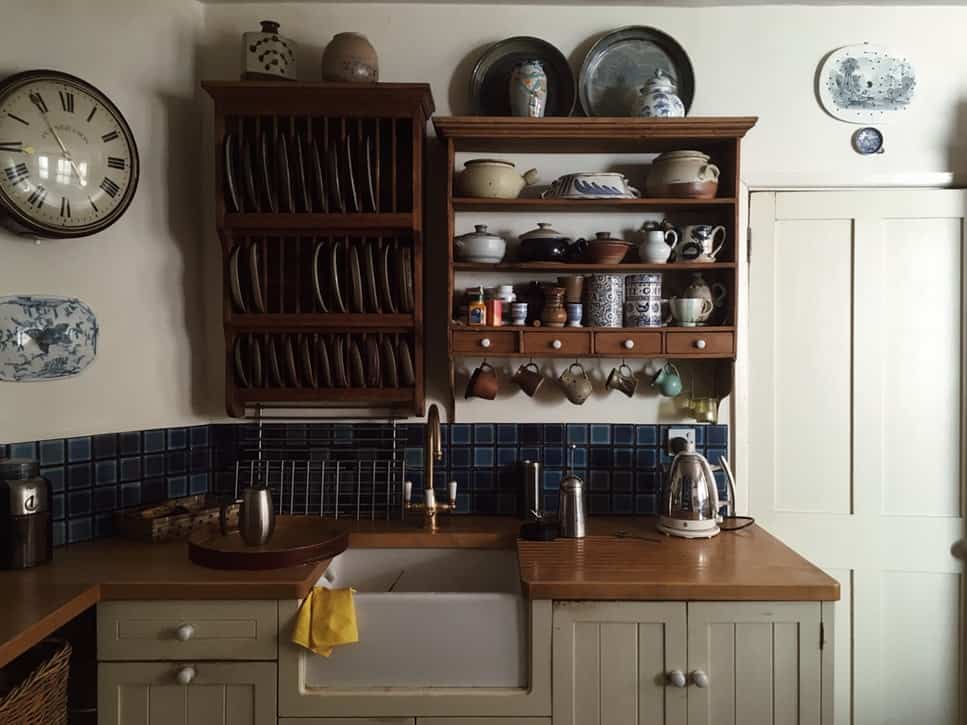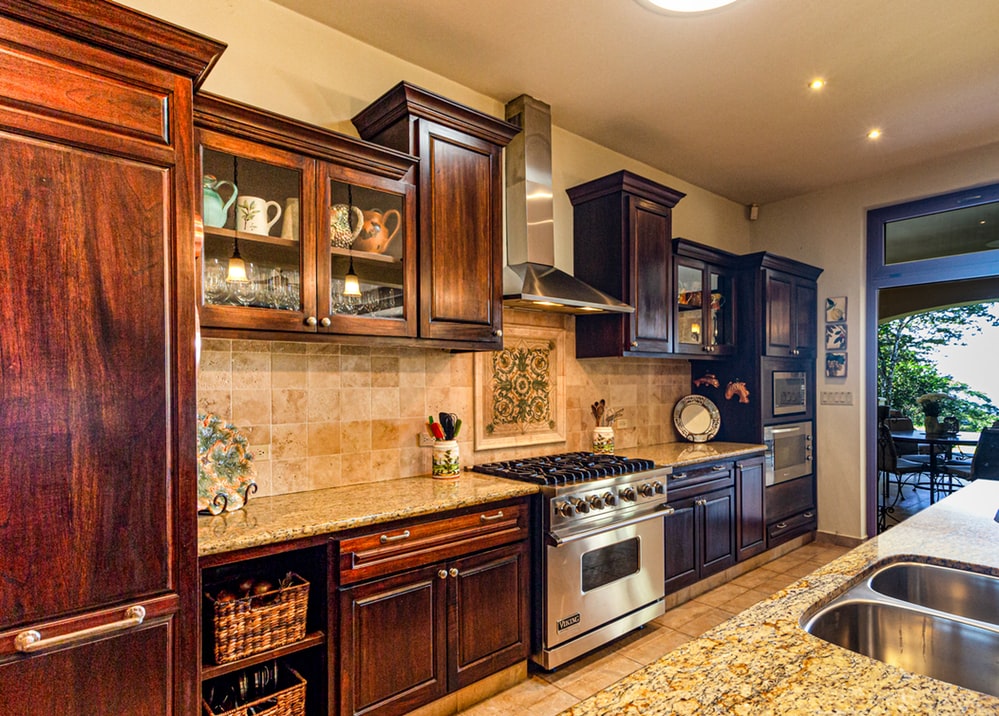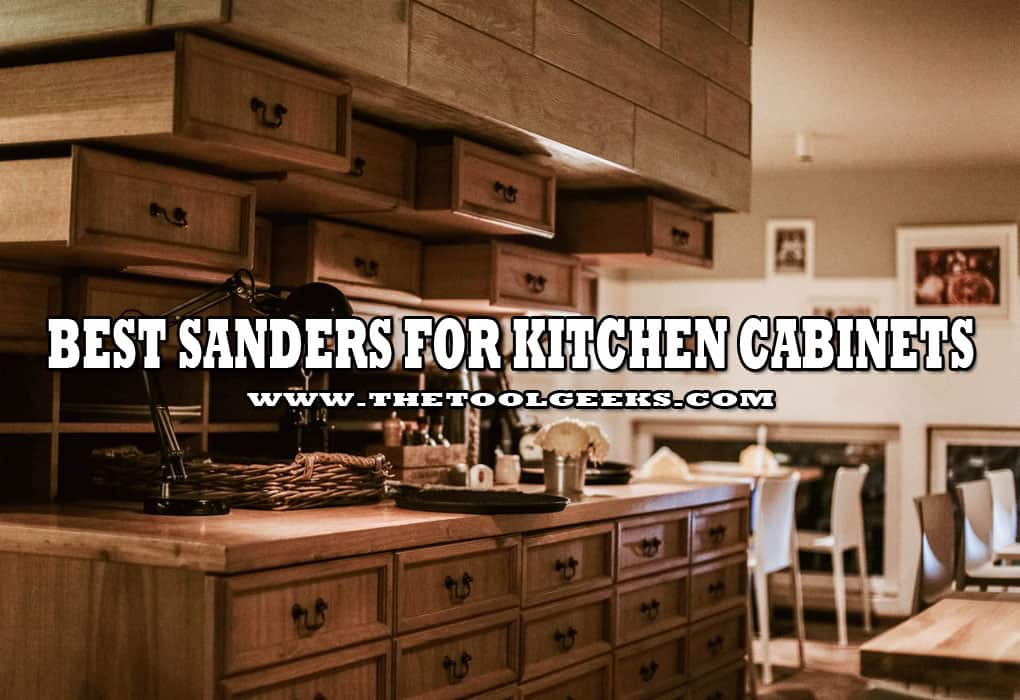Best Sander For Kitchen Cabinets: Top 5 Tested + Reviewed
TheToolGeeks.com is a participant in the Amazon Services LLC Associates Program and other affiliate advertising programs. We may earn from qualifying purchases. (Learn More).
There are many different sanders available with many different features. You cannot pick any random sander for sanding your cabinet because not every sander will align with your requirements. That’s why we’re here with the list of sanders so that you can choose the best sander for your kitchen cabinets.
We tested these sanders on kitchen cabinets to know if they are worth buying, assessed their advantages and disadvantages, and identified any unique features they may have.
Jump To Page Contents:
Best Sander for Kitchen Cabinets – Quick Features Comparison
| Products | Product Name | Details | Price |
|---|---|---|---|
Professional | Professional |
| Buy On Amazon |
Fewer Vibrations | Fewer Vibrations |
| Buy On Amazon |
No Swirl Marks | No Swirl Marks |
| Buy On Amazon |
Very Powerful | Very Powerful |
| Buy On Amazon |
Pressure Light | Pressure Light |
| Buy On Amazon |
Which material are Kitchen Cabinets Made Up Of?
Most of the time, kitchen cabinets are made of plywood because it is highly accessible and robust. Additionally, the material is moisture-resistant, repairable, and easily replaceable.
Another material is particle board that is also known as chipboard. This material is low-density fiberboard (lightweight, affordable, and durable for the cabinets).
Some kitchen cabinets are made up of MDF, a medium-density fiberboard ( it is strong, durable, and resistant to warping or expansion through temperature or moisture changes). It is easily paintable and has high screw-holding power.
Hardwood is also a popular material for cabinet making (durable, repairable, and harvested from trees) with a unique texture.
However, all of these materials are wooden based, so the sanders needed for this material would be almost the same. The sanders we will discuss further will be best for all these materials.
What Kind of Sander Is Best for Kitchen Cabinets?
There are different types of sanders that you can use for kitchen cabinets. The sheet sanders, random orbital sanders, and belt sanders are the ones that are used the most.
Depending on your cabinet condition, you can use one or the other. Belt sanders are very powerful, so if you have to sand old cabinets, they are your best friend. But, these types of sanders are bulky and hard to control.
Random orbital sanders and sheet sanders are suitable for standard cabinets, they also offer variable speed settings, and you can easily control them.
Avoid using detail sanders; those types are not made to remove materials from cabinets.
Best Sander for Kitchen Cabinets – In-depth Review
We tested these 5 sanders on kitchen cabinets (mostly plywood and chipboard) for an in-depth review. We’ve been using these sanders on several woodworking projects (sanding cabinets included) for some time. So we already knew they’re best, but to give you an in-depth review, we specifically tested them on kitchen cabinets.
- Variable Speed Settings
- Paper Clamping System
- Professional
More detailed review ↴
Bosch OS50VC is an electric sander made of aluminum. It weighs 0.03 pounds and is 17.9 x 5.8 x 8.9 inches in dimensions, making the sander lightweight and easy to handle. During testing, it was very easy to handle, but we noticed that it was hard to control this sander while sanding because of its lightweight.
We loved the paper clamping system on the sander that comes with the motion of the front clamp so you can pull the sandpaper flat and tight while you secure it, which helps to get an accurate paper fit. Additionally, flushing sanding enables sanding vertically on 3 sides, so it is versatile.
It works on a 3.4 amp and 120 volts with ½ -inches finishing belt that spins the pad. We loved the front of the sander that is removable (it reduces hand fatigue).
The two dust collection systems, including transparent micro-filter dust canisters with an integrated paper filter, control maximum dust particles.
The sander is a 5-inch disc size that works best for wood and other material. You can use it comfortably for kitchen cabinet sanding.
What makes this sander special is that it comes with a vibration control (Bosch-made) that reduces the vibrations a lot. But, still, we faced difficulty keeping the machine static at a specific point.
- Variable Speed Settings
- Dust Collection System
- Fewer Vibrations
More detailed review ↴
Another sander we tested on the kitchen cabinets is DEWALT DWE6423K. It is also an orbital sander (ideal for any material). We could get excellent results on kitchen cabinets with even pressure.
The sander has a hook and loop style (8 holes) and a 5-inch disc size. It is a coarse grit-style sander and is almost 4 pounds weighed. We use this sander for DIY, small, and medium-scale woodworking projects, and we’d not recommend it for large-scale sanding projects.
The things that make this sander special are its speed and its power. It features a potent motor (3.0 Amp). The motor has variable speed settings, meaning you can change the speed to match your project. The motor spins the pad at 8,000 – 12,000 OPM.
Another thing we liked while testing was the separate counterweight that reduces the vibration, and the grip (rubber made) made our sanding work easier. The sander is small, which was helpful as we could sand in narrow areas.
This orbit sander has an exquisite dust collector, and the bag size is big enough for medium-sized projects (sanding cabinets). The switch of the sander is dust sealed, making it long-lasting.
In comparison to our first, this sander is easier to work with. Plus, the sander’s height is lesser, so you can easily control the sander.
Additionally, you should be careful with this sander, as it has no soft start (It blasts immediately).
- Variable Speed Settings
- Dust Collector
- No Swirl Marks
More detailed review ↴
The third sander we tested on kitchen cabinets is Bosch ROS20VSC random orbital sander. The sander combines pad orbit and rotation; both help it deliver fast and smoothly blended finishing.
We usually use this sander with fine-grit sandpaper, and we always love working with it as it doesn’t leave any swirl marks (smooth finish). Swirls are a pervasive problem with random orbit sanders, but luckily Bosch has figured out a way to get rid of it with its unique braking system.
This sander features an 8-hole and 5-inch disc that works hook and loop.
We loved the speed variability of the sander, which is between 7500- 12000 OPM, adjustable according to your finishing requirement. We set this sander on the fastest speed to remove something from the surface (paint or marks) and then switch to lower speeds and finer grit sandpaper to get a smooth finish.
This sander pad orbit and rotation provide well-blended finishing while having 35,000 long life hooks that provide a firm grip to the disc.
This finishing sander has an excellent dust collection system. The dust collection system has a built-in micro-filter system; it can collect even the finest dust (1/2 micrometers in diameter). Moreover, the dust canister shows dust level and is easily detached.
- Very Powerful
- Dual-Mode
- Durable
More detailed review ↴
Bosch GET75 random orbit sander has a dual-mode setting. You can change the mode depending on the project you are working on. The first mode is the “normal” mode; we use this mode when we’re dealing with standard cabinets and when I want a high-quality finish.
The second mode is the “turbo” one; we mainly use this mode when dealing with ancient and rusted cabinets; the turbo mode is 5 times faster than the normal mode.
While testing this sander, we were comfortable because the counter-weight balance prevents hand fatigue and reduces vibration so you can work longer.
It has a 7.5 amp motor and backing pad that spins at 3,300 to 7,300 OPM ( 273-635 RPM) (no load speed: 640 RPM, no load orbit speed: 3300 to 7300 OPM), providing power and a multi-hole pad system allows flexibility used for abrasive discs, especially for stripping cabinets. (it was fun to work with this sander).
The sander is a 6-inch disc size with an auxiliary handle that mounts on each side. That’s why we could easily control this tool even in turbo mode.
Like the previous one, this random orbit sander features a braking system that helps eliminate the swirl marks (a common problem with random orbit sanders).
It also has a passive dust collection system, requiring a vacuum and hose adapter. Still, the finishing sander has the excellent feature of a dust box so you can dispose of and keep dust away to make your environment clean.
It weighs 5.7 pounds and is 15 x 6.3 x 5.5 inches in dimensions, so it is a little heavier than other sanders on our list.
- Budget Pick
- Pressure Light
- Fast
More detailed review ↴
If you are a beginner and don’t want to spend much money without having enough experience, then this one is a perfect choice. This sander is budget-friendly while being a good performing sander too.
The sander is also a 5-inch disc size that does not need an external vacuum to clean dust particles.
We did not personally test this one but interviewed some woodworkers who use this random orbital sander. The best feature of the sander is pressure control which warns the users when they use excessive pressure.
Most users could use it for improvement projects and finishing touches (so you can use it for kitchen cabinets without hesitation).
This sander also does not leave swirl marks, and the pad brake minimizes gouges. The workspace is always clean through its micro-filtration, which collects almost all the dust particles. This sander is also durable because of its dust deal feature.
The sander accepts universal orbital Velcro sandpaper without any problem. Its motor draws 2.8 amps and gives 12,000 RPM ( no speed variability).
We didn’t like the dust bag of this tool. It’s low-quality, and you will break the tabs if you are not careful enough. The bag itself is not strong either. Except for this, you will get an excellent sander for its price.
Tips for Sanding Kitchen Cabinets
Here are a few things to remember while working with sanders on the cabinets.
- First, clean your cabinets. (No oil and dust should be present on the cabinet surface.
- Next, work with fresh sandpaper on the sander.
- You need to float on the surface. Avoid putting too much pressure; otherwise, you will ruin your wooden cabinet.
- Most of the cabinets have complex designs. So you can work with orbital sanders, as they make it easy to work on corners or small locations.
- Start by applying less pressure and less grit sandpaper and gradually increase the grit.
- You should sand back and forth or in a circular motion, depending on the shape and design of your cabinets.
What Kind of Sander Do I Need for Cabinets? (Factors You Should Consider)
Sanding can sometimes be difficult, so having the right tools is essential to get the right results. A wrong sander can make the whole sanding cabinets project go to work without you noticing.
If you incorrectly sand it, then you can destroy its air-tight features. To avoid that, you must know what features a sander should have.

Weight and Size
Kitchen cabinets come in various sizes; you have small and big ones. You need to reach the inner sides and the corners while sanding.
That isn’t possible with every sander. Small sanders are suitable for dealing with corners, but they will take longer to complete the project because they are small. You should find a medium-sized sander.
The sanders we talked about are mostly under 4-5 pounds, which makes them easy to work with and comfortable to handle.
Variable Speed Sanders
Some sanders come with variable speeds, and others don’t. That feature isn’t necessary, but it does help a lot. You don’t need to use many sandpapers or change them frequently, you can change the speed, and you are good to go.
It is helpful when dealing with cabinets; buying a variable-speed sander means using the same sander for different tasks. Most of the sanders we have listed here have a variable speed feature. They might cost more, but they are always worth it.
Power
When looking for a suitable sander, one of the first things you should consider is power. You should look at the motor specifics to know how much power a sander has. Usually, the motor power is quantified in amps; lookup for numbers such as 2.5 Amp and 3.0 Amp.
When dealing with cabinets, the amount of power you need is 2.5 Amp or more. Most of the sanders we listed are under these requirements.

Dust Collection System
As you may know, sanding produces a lot of dust. You have to get rid of the dust before you inhale it. Dust can be horrible for your health. Most sanders come with a dust collection system, meaning the sander removes the dust.
I recommend you choose sanders that come with this system, plus have the option to connect another vacuum. Some sanders even have a micro-filter system that removes even the finest dust.
The holes under the sander grit define how the dust collection would be. The sander we have listed has up to 8-holes: they collect the smallest particles and keep the environment as clean as possible.
Read Also: Best Sander For Trim WorkFrequently Asked Questions About Cabinets Sanders
1: What Should I Use to Remove Dust After Sanding?
Most of the sanders come with a dust collector system, meaning that the sander will get rid of most of the dust if not all. But if the sander doesn’t get rid of the dust, you can always use a vacuum cleaner or even water to remove dust.
2: Should I Sand Kitchen Cabinets Before Painting?
Yes, it is done to achieve an even surface before painting. You can do that manually with sandpaper or with a sander. I’d recommend you use a sander to get the best results possible.
Conclusion
Why do sanding when you can paint the kitchen cabinets without sanding? Because it gives a smooth finish and allows easy and less paint coating while achieving fine required results.
While sanding, you need a powerful yet speed variability while sanding to control your sander. Grit numbers vary according to your need, and the weight needs to be checked to ensure it allows easy handling.
We’ve added the best sanders for kitchen cabinets after testing and using them on kitchen cabinets, making it easy for you to select that suits your requirements.
Amazon and the Amazon logo are trademarks of Amazon.com, Inc, or its affiliates.











